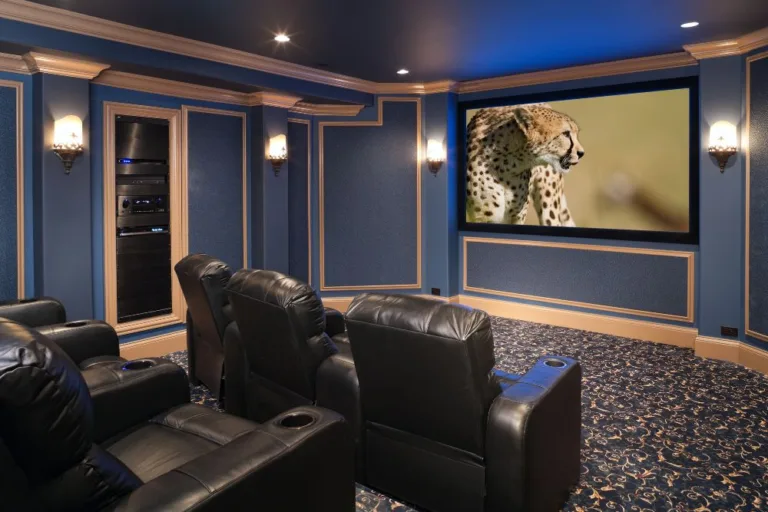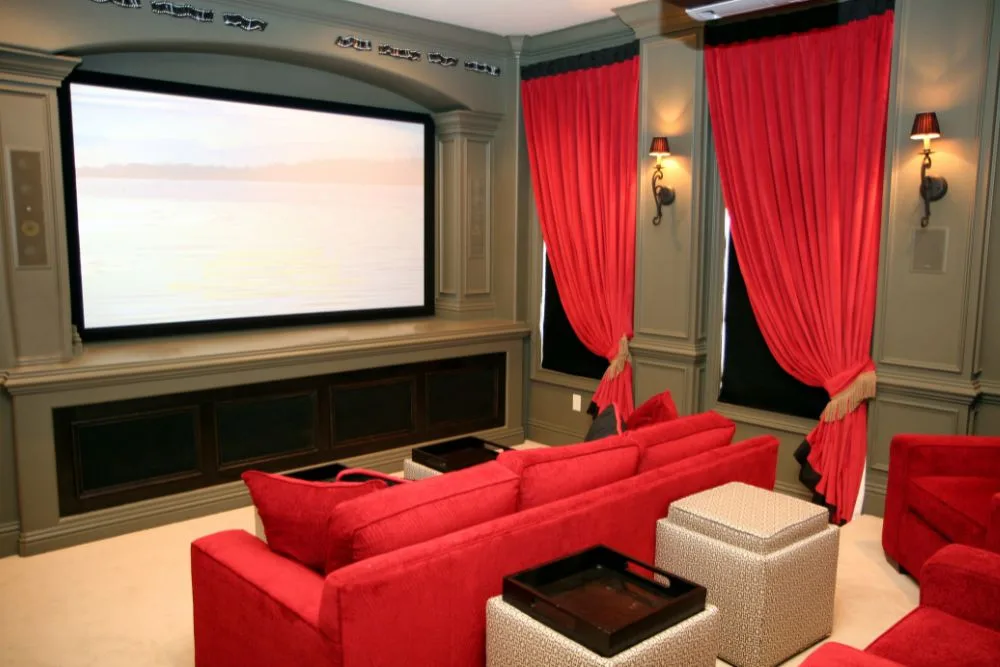Transforming Your Basement Into a Home Theatre
Posted on: 2024-02-01
Transforming your basement into a home theatre is a rewarding project that can enhance your living space and entertainment options.
Whether you’re a movie buff or a gaming enthusiast, creating a dedicated home theatre offers a unique experience right in the comfort of your own home.
This guide will explore the key steps and considerations involved in renovating your basement into a cinematic haven.
Planning Your Home Theatre
Before you start renovating your basement to create a home theatre, there are some key things you should consider:
Assess Available Space
Consider factors like ceiling height, layout flexibility, and any existing structural elements that may impact your design choices.
You should also make sure there’s enough room for seating arrangements and audio equipment.
Taking precise measurements and noting any potential obstacles will help you plan your home theatre layout effectively.
Figure Out Your Budget
Establish a realistic budget for your basement renovation project. This should include the cost of equipment and furnishings and potential expenses related to permits, professional services, and unexpected challenges.
Factor in a contingency fund for unexpected costs, ensuring that you are financially prepared for any unforeseen challenges that may arise during the renovation process.
Purpose and Functionality
Clearly define the purpose of your home theatre. Will it primarily serve as a movie-watching haven, a gaming retreat, or a multifunctional space?
You should also consider the specific needs of your household, such as accommodating family movie nights or creating a dedicated gaming space.
Essential Equipment and Tech
What would a home theatre be without some fancy tech and toys? Here are the most important things you need to plan for:
Audio Systems
Invest in a quality audio system to enhance the immersive experience.
Consider surround sound setups, soundproofing solutions, and acoustical treatments to optimize audio quality.
Also, ensure proper placement of speakers for optimal sound distribution, and look into incorporating sound-absorbing materials to reduce echoes and enhance clarity.
TV and Screens
Choose an appropriate TV or projection screen based on your space and preferences.
Pay attention to resolution, size, and viewing angles to ensure an enjoyable visual experience, and consider the distance from seating areas to the screen to determine the ideal size for immersive viewing.
Carefully position the TV or projector screen to minimize glare and maximize visibility from various seating positions.
Lighting
Incorporate dimmable lights and ambient lighting to create a comfortable and visually appealing atmosphere.
Experiment with different lighting levels to find the perfect balance between visibility and ambiance.
You can also install smart lighting systems that allow you to adjust brightness and color temperature according to different activities, such as movie nights or gaming sessions.
Designing the Atmosphere
From seating arrangements to decor, don’t forget to factor in what you want your home theatre to look like:
Seating Arrangements
Select comfortable and appropriately sized seating for your home theatre. Consider the optimal viewing distances and angles to create a cinematic atmosphere.
Look at options like reclining chairs or sectional sofas for added comfort during extended viewing sessions.
Decor and Aesthetics
Go with a theme or style that complements your entertainment preferences and personal taste.
Also, choose a color scheme that enhances the cinematic experience, avoiding overly bright or distracting colors.
Customizing Your Space
Take advantage of your basement space by including custom storage, built-in cabinets, and specialized furniture to optimize functionality.
You can incorporate hidden storage for media devices, cables, and accessories to maintain a clean and organized appearance.
The Renovation Process
Now that you have everything planned out let’s talk about transforming your basement into an envy-worth home theatre. Here are the things you need to keep in mind:
DIY Basement Renovation
For the hands-on homeowner, consider undertaking a DIY basement renovation. This may involve tasks such as insulation, flooring, and basic construction.
Make sure you have the necessary tools and safety equipment before starting, and follow step-by-step guides or video tutorials for each task.
While DIY can save costs, be realistic about your skills and the complexity of the renovation, seeking professional help for tasks beyond your expertise.
Hire a Professional
If the project scope is extensive or requires specialized skills, hiring a professional contractor is advisable.
A professional contractor will manage the project timeline, coordinate various tasks, and address unexpected challenges efficiently.
Permits and Approvals
Check local building codes and obtain any necessary permits before starting your renovation.
Compliance with regulations is essential to avoid setbacks and ensure a smooth process.
Obtaining permits not only ensures legal compliance but also provides assurance that your home theatre meets safety standards and building code requirements.
Common Challenges and Solutions
Not every project is guaranteed to go smoothly, but don’t worry! Preparing for challenges is the best way to find quick and easy solutions:
Moisture and Waterproofing
Address potential moisture issues by using waterproofing measures, such as proper drainage systems and moisture-resistant materials. These can prevent damage to your home theatre.
Inspect your basement for signs of moisture, such as water stains or musty odors, and address any existing leaks before starting the renovation.
Apply waterproof sealants to walls and floors, and consider installing a sump pump for additional protection.
Potential Structure Concerns
Hire a professional to assess the structural integrity of your basement, identifying any issues that may compromise the safety or stability of the space.
Address concerns such as cracks in walls, sagging beams, or uneven floors promptly to prevent further damage.
Proper Ventilation and Climate Control
Make sure your basement is properly ventilated to maintain a comfortable environment.
Consider installing HVAC systems and ventilation fans to regulate temperature and air quality.
Take a look at your existing ventilation in your basement and enhance it with strategically placed fans or vents. Install a dehumidifier to control moisture levels and prevent mold growth.
Basement Renovations in Edmonton
Are you ready to transform your basement into an amazing home theatre?
Elevate your entertainment experience by entrusting your project to the skilled professionals at Parabola Developments.
Contact us today to turn your dream home theatre into a reality!




